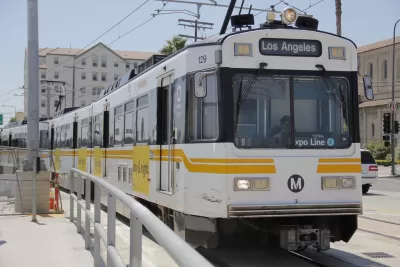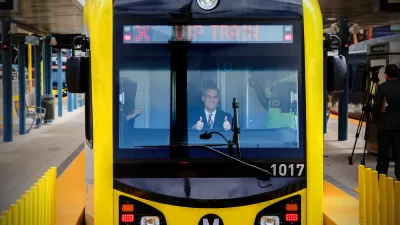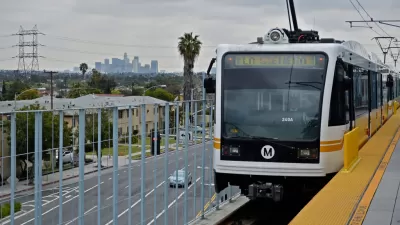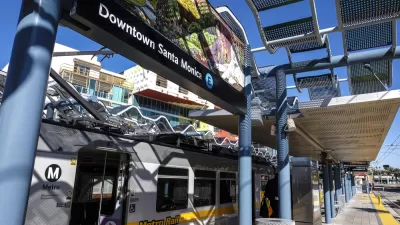The $1.5 billion, 6.6-mile light rail extension from Culver City to Santa Monica is projected to double trips on the line by 2030, giving commuters a viable alternative to driving. Just the same, don't expect the extension to reduce congestion.


Credit: LA Metro Expo Line (note seven new stations: Palms—Santa Monica)
"The light rail extension won’t put a dent in traffic, not in the long run," writes Aarian Marshall for Wired. "But it’s still worth every penny.“
So much for Los Angeles Mayor Eric Garcetti's assurances last February.
The Expo Line connects and crosses through some of our most traffic-ridden corridors,” Garcetti said. “This is a huge step forward in our work to ease congestion.”
Induced demand applies to transit as well as asphalt
Growing the ridership by 35,000 trips to 64,000 in 14 years will be a major feat, but how will the extension impact congestion? Marshall asks transportation expert, Professor Genevieve Giuliano of the University of Southern California (USC) what the effect would be if ten thousand motorists chose to immediately forsake driving and take the Expo Line. Giuliano has been studying the issue.
“Ten thousand vehicles out of literally hundreds of thousands that are moving around—it would be really hard to see,” she says.
In a study published last year, Giuliano and her colleagues used sensor data to take a close look at how the opening of the first phase of the Expo line in 2012 affected congestion in the immediate area. They didn’t see much. “The congestion reduction benefits of [light rail] are likely very limited,” they concluded.
You can thank the rule of induced demand: More space for cars doesn’t mean less traffic, it means more cars. When folks ditch their cars for a smooth and stress-free transit ride, other drivers move to exploit a suddenly less clogged stretch of freeway, either by changing their driving patterns or taking trips they wouldn’t have otherwise. The new Expo Line will move more people more places, sure. But it won’t cure traffic.
Looking at Planetizen posts tagged under the topic, it's easy to see that the concept is generally applied to adding more vehicle capacity, which has the adverse impact of reducing transit ridership, unlike adding transit capacity.
“The best thing you can say is that [the Expo extension] will provide people with an option for traveling in congestion,” says Brian Taylor, director of UCLA’s Institute of Transportation Studies.
Taylor is wary of exorbitant rail projects that are attractive to voters but may "betray 'transit’s critical social service function'": improving the lives of lower income people, particularly when lower-priced, high-frequency bus service may prove more cost effective.
A few streetcar projects that may fall in the category were posted here recently.
A final note on the transit—traffic congestion relationship taught to me by public transit advocate Roy Nakadegawa. While transit may not place much of a dent in traffic congestion, congestion prompts the need to create and improve public transit, as well as adding road capacity. Perhaps the best way to tackle congestion is through economic means.
See more Planetizen coverage of the Expo Line which opened Friday after six years of construction.
Hat tip to Metro Library's L.A. Transportation Headlines
FULL STORY: LA’s New Metro Line Won’t Reduce Traffic—And That’s OK

Alabama: Trump Terminates Settlements for Black Communities Harmed By Raw Sewage
Trump deemed the landmark civil rights agreement “illegal DEI and environmental justice policy.”

Study: Maui’s Plan to Convert Vacation Rentals to Long-Term Housing Could Cause Nearly $1 Billion Economic Loss
The plan would reduce visitor accommodation by 25% resulting in 1,900 jobs lost.

Planetizen Federal Action Tracker
A weekly monitor of how Trump’s orders and actions are impacting planners and planning in America.

Wind Energy on the Rise Despite Federal Policy Reversal
The Trump administration is revoking federal support for renewable energy, but demand for new projects continues unabated.

Passengers Flock to Caltrain After Electrification
The new electric trains are running faster and more reliably, leading to strong ridership growth on the Bay Area rail system.

Texas Churches Rally Behind ‘Yes in God’s Back Yard’ Legislation
Religious leaders want the state to reduce zoning regulations to streamline leasing church-owned land to housing developers.
Urban Design for Planners 1: Software Tools
This six-course series explores essential urban design concepts using open source software and equips planners with the tools they need to participate fully in the urban design process.
Planning for Universal Design
Learn the tools for implementing Universal Design in planning regulations.
Caltrans
Smith Gee Studio
Institute for Housing and Urban Development Studies (IHS)
City of Grandview
Harvard GSD Executive Education
Toledo-Lucas County Plan Commissions
Salt Lake City
NYU Wagner Graduate School of Public Service





























